Tips about crate training and toilet training your dog

Many dog owners now crate train their dogs during puppyhood, although adult dogs can be trained successfully also.
Crate training is a practical and humane way of training your dog to tolerate being confined for short periods of time only.
We do not condone crating an Italian Greyhound or any breed of dog for long periods of time.
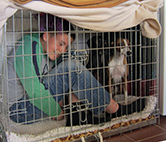
Crates are “den-like” and dogs are den-loving creatures, especially if warm and cosy.
Many Italian Greyhound owners who crate trained their dogs as puppies keep crates in their homes even when the dog is an adult, although by this stage the doors may be permanently open or even have been removed completely.
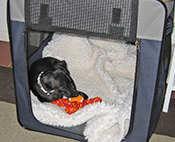
Dogs genuinely seem to love having their own cosy, draught free little den – one of the reasons it is important to have a warm dog bed for your Italian Greyhound, even if it ends up sleeping in your own bed at night!
So why might you want to train your dog to tolerate being ‘locked up’?
The short answer is: for its own safety. Particularly when they are puppies, Italian Greyhounds can be very accident prone – jumping onto furniture, (many an Italian Greyhound will surprise you by springing up onto a kitchen worktop),
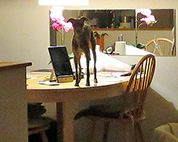
leaping off furniture, chewing through electric cables, etc.
If you train your puppy at a very young age to tolerate short periods of confinement in a crate, (perhaps with a chew toy), then you will be able to leave your puppy safe in the knowledge that it can’t hurt itself when you are not there to supervise e.g. when you pop out to the supermarket.
Read more about how to prevent "home alone" problems: www.sighthound.net/aloneathome.htm
Crates are also perfect for travelling with your Italian Greyhound in the car. A crate secured on the back seat of your car is the safest place for an Italian Greyhound in the car. Why the back seat? Because most modern cars are designed with a rear that crumples on impact which means any dog in the boot of the car is likely to be crushed, (and thrown about) if the car is hit with force from behind. Plus, car boots are often cold and draughty.
Note: If you decide not to crate your dog when travelling in a car, then you must ensure that it is secured with a special dog seat-belt harness. If you have to brake suddenly or swerve, then your Italian Greyhound will be sent flying off the seat and it could break a leg – or far worse.
Note: A dog must be trained to be confined in a crate so it feels it is a perfectly natural thing – it’s not fair to the dog if you suddenly lock it up for several hours out of the blue and expect it to be perfectly content.
There are many good training books that give advice on how best to introduce your dog to a crate and how to gradually build up the time that it spends in the crate without causing distress to the dog.
Remember too that if your dog is confined in a crate he/she should always have access to fresh water.
Water bowls that clip onto the sides of a crate are best so that your dog can’t knock the bowl over or step in it.
An alternative way of confining a dog for its own safety is a play pen – just remember that Italian Greyhounds can jump surprisingly high and even young puppies may have no problems springing over the walls of a play pen.
As your dog gets older and wiser, the need to crate your dog when you are not there should disappear, although the majority of Italian Greyhound owners will ensure that their dog does not have free run of the house when home alone even when they are older.
One should restrict them to specific room(s) in the house.
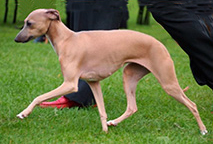
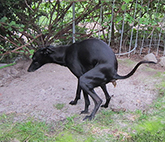
House training Italian Greyhounds
Italian Greyhounds are notoriously difficult to house-train. Anyone considering one really needs to think this through as it could mean a lifetime of dealing with puddles by the back door and leg-lifting on furniture by both dogs and bitches – bitches mark just as much as dogs do! That is if you haven’t trained it properly.
There is lots of different advice on how to house-train a dog. No one seems to have a magic solution with Italian Greyhounds. Speak to fellow dog owners and seek their advice on what worked for them. A sound piece of advice is never let your dog pee or poop inside from day one.
This is quite a task as it means you have to anticipate when your dog is going to need to toilet and then take it outside to do its business when it wakes up, when it has eaten, when it has finished playing or done anything else “exciting”, e.g. postman rings the doorbell, and then every hour on top of those times.
The idea is that your dog learns very quickly that OUTSIDE is the only place to pee and poop.
This is a very effective training method but very labour intensive – however, if you can take this approach it will save you a lot of frustration in the future!
Remember that puppies and young dogs need to “go” much more often.
Adult dogs can hold themselves for much longer.
Also: Use an appropriate command word or words – and when your Italian has understood the system, it will begin to ask you when it needs to go outside. It is only for a short period in a young dog’s life – or a Rescue dog who might need re-training.
Read all about it here: www.sighthound.net/cleanpups.htm
Tip: You can also make your own "doggy toilet" by creating a raised area filled with sand and some bushes or decorative flowerpots. Here is one used by a Whippet. (Taken on a foggy day for discretion!)
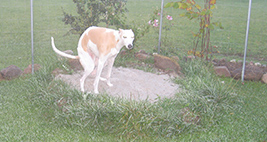
Tip: To get your Italian to hurry outside in all weathers, throw a tiny morsel of its normal kibble out of the door and it will shoot outside after it! Use a suitable commando as well. This is a big help when it is raining etc. – they are out of the door before they realise how bad the weather is!
Tip: If you adopt a dog from an internate or dog prescue, or take over an older dog from someone else - start by treating it like it's a puppy, in order to ensure it quickly becomes clean in your home.
